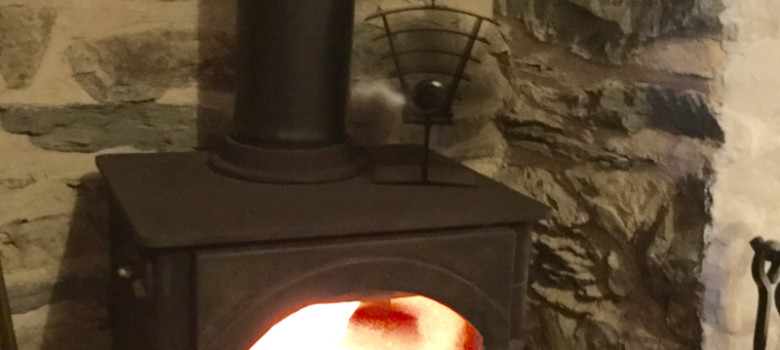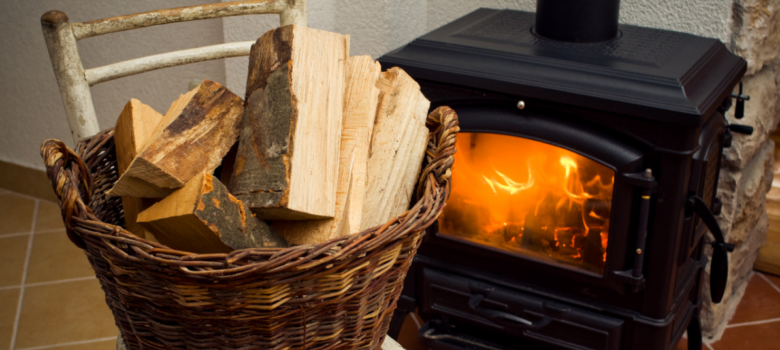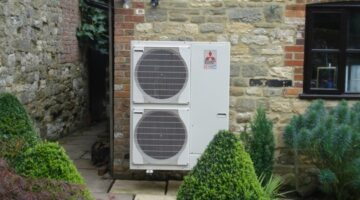
It’s now winter; all of the lights are already on at 4:30 and we have started to rely on the central heating. One comfort I have is that once I get home, I can put my feet up and feel the warmth from my wood-burning stove. It is really cheap to run and saves me plenty of money compared to turning the central heating on.
Pre-stove fan problems
The problem is that if I don’t position myself fairly close to the stove and singe my eyebrows, I don’t really feel the warmth. This is because most of the heat generated heads straight up to the ceiling and then the floor above due to convection. Although this is lovely when I get to bed, it is far from ideal. So this led me to try a stove fan.
What are stove fans designed to do?
Designed to rapidly improve the circulation of heat from the stove, and therefore reduce hot and cold spots throughout the house, stove fans aim to not only improve comfort but also improve the stove’s efficiency and reach.
>>> How do stove fans work? >>>
Read on to find out more about our hands-on review!
So how did it work for me?
The main concerns I had before I tried it were noise of the rotation, aesthetics and actual effectiveness. Much to my surprise, as I’m a northern cynic at heart, I found it to be quiet, blend in to the stove and actually increase the comfort and ‘effective warmth area’ of the room. No longer did I have to sit close to the stove to feel the heat! Result!

How do they work?
The heat from the stove drives their motion, which allows for a seamless and quiet operation. The start up temperature varies depending on the make and model, but I’ve found that it’s pretty quick from the initial flame. Be careful to have a look at the maximum temperature as some models have to be taken off the stove after a while (using heavy duty heat proof gloves of course) – the maximum for the Phoenix stove fan is 3400c, so no such problems here!
Instead of the heat rising vertically with a standard stove, the stove fan uses its blades to divert the warm air horizontally. This means it will heat the part of the room you are sitting in, rather than just the ceiling. The extra movement of air will help warm the whole of the room, not just the area near the stove.
Below is a video of a test fan
The fan starts very quickly in the video; this is due to the temperature of the stove at the time! If the fan is just sitting on the fire as it is lit, it will take time to warm up sufficiently to start spinning.
Should you get a stove fan?
If you want to increase the efficiency of your stove, have a more comfortable heat throughout the room and remove hot and cold spots then I can honestly say that a stove fan is absolutely the energy efficient gadget for you.
Benefits of the stove fan?
- The stove fan results in quicker dispersion of heat
- Reduction of hot and cold spots
- Reduces stove heat requirement (and therefore fuel cost)














We installed one of these stove fans and they are absolutely fantastic. It had to be a mini so it fitted on top of the fire, but it still kicks out loads of heat. And I love they ways they use the heat to spin, no electricity required, very simple idea but hugely affective.
How big are they? Don’t want anything tat looks cheap and sh*t
Hi Akon, the Valiant PremiAIR 4 Heat Powered Stove Fan that we tested above is 199mm high, the Smartfan mini is 190mm high.
We bought one of these stove fans a while back and it made such a difference to our fire place and the heat output. They fan takes longer to spin than the video shows mind. The fan must of already been quite warm! I think ours takes about a minute to start spinning.
Great addition to the stove. Really does start to belt out the heat over a bigger area. Would recommend to anyone, and have even purchased one for my sister. What is their lifespan just for future reference?
Bought me a stove. Was great.
Buy a fan for it
I bought one of these to use on my Soapstone stove but it never gets hot enough to get the stove fan spinning. So annoyed cause they seem like such a great idea. Anyone know of a low temperature one that works sub 65 degrees?
Hi Paulie, the SmartFan Low Temperature (LT) starts working at 60 degrees so should be perfect for you.
How often do you need to change the batteries in these fans? Also do they sense the temperature and then automatically turn on or do you need to switch them on every time you light the fire?
As it is a sterling engine, it in fact doesn’t run on batteries but uses the heat from the stove to work. It therefore spins automatically as soon as the required temperature is reached.
we bough the valiant stove fan reviewed here and it works great. If you have a stove, then getting a fan for it is an absolute no brainer cause the room warms up so much quicker.
Bought a Valiant and works great, anybody know how long they are meant to last? does the motor inside start to degrade and fall apart because of the heat?
I bought a stove fan last autumn to help move the heat more effectively around my living room. The really do seem to do the trick although you need to have space to install on (which would be impossible if the stove was built into the chimney space). I think you can get the low temperatures ones now for the standstone heaters too.
WHAT ARE THE ADVANTAGES DISADVANTAGES OF TWO OR FOUR BLADE FANS. we HAVE A 9KW WOOD BURNER?
Is it possible to buy a stove fan that will work with a built in multi fuel burner. I have an alcove in the fireplace above the fire, could I stand it there?
Hi Maureen, it depends how hot the alcove gets. In truth I doubt it will work, since I wouldn’t of thought it will be hot enough – but that is the only way to tell. I think the stove fans start operating at temperatures of over 65 degrees centigrade (check with the supplier to make sure though as this varies between units!)
Agreed James, the base needs to be heated, the top section as cool as possible for the fan to work. so the fan base has to be in contact with the stove.
Our high ceiling lounge was freezing in the summer do dire in the winter. We bought a woodburner but room is now unbearably hot and heat goes upstairs wen door is open. Would a fan move heat into dining room which is a doors width from lounge?? Tia
Hi
We have a inset woodburner with a ledge of 100mm would a fan be work off the heat from the ledge, it does hot as I found out when I burnt my finger on it!
I went for a Phoenix 4 blade, does the job. Anyone know why you would go 2 blade over 4? bit confused over the reason for different number of blades.
The Valiant Premium 4 pushes more air than the 2 blade fans on the market, the Ventum 3 pushes virtually the same as the Premium 4. The Valiant Ventum II is a punchy little fan pushing the same air as the “standard” 2 blade fans, but blows harder, form a smaller diameter fan – great on narrow-boats, or where heat is required to be pushed further.
Valiant Premium and Ventums have the 2 year guarantee too.
My Stove Fan doesn’t make that much difference to room temp as my wood burner is fully exposed to the room. The claim that it saves on fuel costs is absolute rubbish!
I have a log burner with a hood and no where to ohysically put a fan. It is an inglenook fireplace…could I put a metal shelf into the wall to place the fan on? .have you any other ideas please? Many thanks
Hi Lisa, I don’t think the shelf will get hot enough to be honest – so I don’t think this will work for you.
Is there such a device for a built-in woodburner, please? That is to say, a woodburner whose flue pipe is not accessible.
Would a vertical mounting kit work? Like this: https://stovefanreviews.com/product/sirocco-plus-stove-fan/ – this business is nothing to do with me, I just came across it.
Hi Maria,
Not that I have come across! Sorry we can’t help!
Hi all, I have a high top hood on my stove(witches hat) with top flue, no room behind for rear flue, so no room/enough flat surface to fit a stove fan, can I attach a 2mm thick aluminium shelf to the side of the hood making sure as much metal as possible is touching the hood and sit the fan on that? Will the ally melt, will it work? Regards, Steve
Hi Steve, it depends entirely on how hot this new metal shelf will get to be honest. Most of the stove fans need to reach at least 60-70 degrees before they start rotating. There are some that operate at slightly lower temps, but not many! So build the shelf and get a thermometer on it!
I have a woodburner and when on the room is unbearably hot, the door out of the sitting room is opposite side of the room about 5 metres away. Would the fan blow heat out of the door?
Bought a stove fan and it spins away merrily, But, that all it does. if you want an interesting looking mobile ornament then its for you. as to making the slightest difference to the temperature anywhere in the room, forget it. For me it was a waste of money which I could have paid for more petrol for my chainsaw with.
Hi there,
We have inherited an insulated woodburner, the type you can put your hand on and not get burned…
It has a back boiler which is supposed to heat the central heating (although this is not very efficient!)
It doesn’t throw much heat into the room, but as the top doesn’t get very hot I wondered whether a fan would work or not.
Can you advise please?
Thank you so much,
Louise 🙁
Hi Louise
It sounds as if the normal fan setup will be no good for you as the system needs a hot base (much more than hand heat) surface for the electronics to work.
However, one of the previous replies suggests that a specific brand can be attached to the door glass, and this might work.
I haven’t got one yet, but will do so soon.
Hi… i’ve just bought an eco fan and found there is no space to put it behind the flue…. The only flat surfaces are in front of the flue which is where I thought it would sit.. I may rig some kind of metal plate to enable it’s position. Any experience with this problem?
have had a fan on my woodburner for 6 years…used every day for 4 months each winter, so adds up so far to 2 years of constant use.. BRILLIANT item, pushes the heat around the room rather than just to the ceiling and going upstairs, no more cold spots in the room. Please note, there is a thermal paste that needs replacing every few years, easy fix, there are lots of videos online showing how to do it… Is the fan worth the money…YES
Ive got a woodwarm stove that is set into the chimney breast. What type of fan do you advise?
I am not sure they do work or mine anyhow:. simple test is to hang a thread or piece of wool in front of the fan when stove is hot and fan is spinning. If it doesnt push out the thread with the fan’s pushed air how can it be working effectively? Mine shows no decernible air flow coming from it despite spinning very fast. The Principle is fine. A proper fan positioned above and behind the stove would certainly push hot air out into the room …but these items. I have my doubts. They spin really fast so give the illusion of doing something. Or is it just my one which was not particularly cheap??
Actually apropos of above comment I tried bending the two blades somewhat increasing the angle and by spinning it I find it has improved the air flow. Maybe that was the problem the blades were not angled sufficiently to push air out